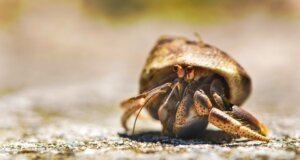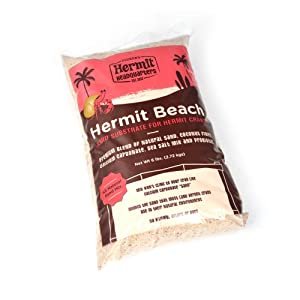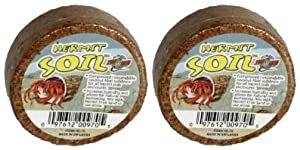Believe it or not, the substrate is the most important part of a hermit crab’s habitat. Substrate is the sand (mixed with other materials) you will use within your hermit crab tank or habitat. Hermit crabs depend on this substrate as they use it to bury themselves. One reason is that it provides protection against predators (for camouflage and feeling safe – especially in a new environment), and the other is for when they are ready to molt (shed their old shell). The best substrate for hermit crabs is super important, especially for the longevity of your pet.
The ideal primary substrate in your tank or habitat for your hermit crab should be a good quality sand with some coco fiber mixed in. This helps with the aeration in the sand as well as adding humidity, which is needed to keep the substrate moist.
Hermit crabs’ homes do not need to be elaborate, however, as most land hermit crabs come from warm, tropical climates, keeping their habitat at the right temperature and humidity are vital for their health and survival.
Comparison Table
| Image | Title | Click to Edit | Buy | |
|---|---|---|---|---|
| TopBest Pick |  | Carib Sea ACS05820 Super Natural Moonlight Sand for Aquarium, 5-Pound | 4.5/5 | Check Price |
| Top Performer |  | Exo Terra Coco Husk Terrarium Substrate, 8-Quart | 4.5/5 | Check Price |
| Cheapest |  | (2 Pack) Zoo Med Laboratories Hermit Crab Soil | 4.5/5 | Check Price |
As mentioned above, because the substrate is critical to the hermit crabs’ health and well-being, it is important to get the best substrate for hermit crabs. This may well be one of the most important decisions you will make for your pet.
Top 7 Best Substrate For Hermit Crabs
Best Hermit Crab Substrate Reviews
1. Fluker’s All Natural Premium Sand Substrate Mixture
If you’re looking for the perfect substrate for your hermit crab tank, consider Fluker’s all-natural premium sand substrate. It is designed exclusively for hermit crabs to withstand moisture and encourage natural digging behavior.
Much of the sand sold for hermit crabs is pure calcium carbonate, which is made from small pieces of broken shells. Fluker’s uses something different.
This all-natural premium sand is actually a blend of all-natural silica sand, coconut fiber, sea salt, calcium carbonate, with an added probiotic. Together, these ingredients make the perfect mix for digging, but they also each serve a specific purpose.
Silica sand and coconut fibers retain water. Sea salt is added to mimic the natural coastal habitat and the probiotic helps keep the substrate clean by promoting the growth of beneficial bacteria that break down organic waste.
4.6 STARS
Benefits
- Non-toxix
- Retains moisture
- Formulated mix
- Probiotic
Cons
- Some viewers don’t like that it arrives damp
2. Hermit Habitat Terrarium Sand
If you’re looking for a way to add some color to your hermit crab’s habitat, this beautiful, sparkling blue Hermit Habitat Terrarium Sand might be just the thing.
Don’t worry, the pigments are completely natural and safe for your pet.
This particular substrate is a great source of calcium carbonate that hermit crabs need to grow and form an exoskeleton.
It is 100% digestible and contains no silica or phosphates. It also has a great, regular consistency for digging and a natural odor neutralizer. This would be most beneficial if you have your hermit crab’s tank inside your house.
4.3 STARS
Benefits
- Natural pigments
- Source of calcium carbonate
- 100% digestible
Cons
- Sand is sticky
- Difficult to clean
3. Reptile Sciences Terrarium Sand for Aquarium
This Reptile Sciences Sand substrate is made from 100% natural calcium carbonate sand.
It is obtained from all natural sources and contains no silica or phosphates. The fine texture is really great for two reasons – it’s 100% digestible and perfect for digging.
Another great advantage of this product is the natural, white color. This natural look will help you create an environment similar to where hermit crabs live, when in their natural beachy environment.
This sand is also a natural odor neutralizer that comes in handy between cleanings.
4.6 STARS
Benefits
- 100% natural calcium carbonate sand
- 100% digestible
- White color
- Natural odor neutralizer
Cons
- Poor packaging
- Dusty as the product is very fine
4. Zoo Med Laboratories Hermit Crab Soil
Hermit crabs need a variety of substrates in their habitat to maintain ideal living conditions. If you’re looking for a convenient and healthy way to increase humidity, check out this hermit crab land from Zoo Med.
This product contains two compressed stones. Just add a little water and each expands to seven to eight liters of substrate. You can use it alone or mix it with hermit crab sand. It’s great for digging in and keeps crabs busy and happy.
Each stone is made of coconut fiber. This eco-friendly, renewable material breaks down waste products and absorbs odor, keeping the living environment smelling healthy and fresh.
4.5 STARS
Benefits
- Increases humidity
- Eco-friendly
- Absorbs odors
Cons
- Some reviews say it doesn’t expand to 8 liters
- May need to mix with sand
5. Zilla Jungle Mix
This Zilla Jungle Mix is a mix of peat moss and spruce shavings. Mix it with a little sand and it will help create an ideal home for your hermit crabs. Because it takes up more than its own weight in water, it adds the moisture that hermit crabs need to thrive.
Hermit crabs love to dig and this product has an ideal texture. It is smooth and light, which makes it easy for them to manoeuvre through. This 100% natural product has an earthy scent and is completely biodegradable, so it is also good for the planet.
You can choose from three different sizes: four quarters, eight quarters and 24 quarters. Change it when necessary to ensure that your hermit crabs always have a clean place to dig.
4.7 STARS
Benefits
- Texture for digging
- Smooth and light
- 100% natural
- Biodegradable
Cons
- Some reviews said it had minute splinters/spikes in the mix
6. Carib Sea ACS05820 Super Natural Moonlight Sand
If you’re looking for a great sand substrate to mix or use alone, Super Natural Moonlight Sand is worth checking out. The natural white color is simple, but beautiful, and makes an appropriate background when accessorising your decor for your pet hermit crab.
This product is made in the USA and contains no paint or dyes. It also has no coating, so it’s completely safe for your pet. The super fine and smooth texture also encourages digging for your pet.
One of the remarkable things about the super natural sands of the Caribbean Sea is that it is meant to mimic natural environments. So if you are going for a natural look for your hermit crab’s habitat, then this is it.
4.5 STARS
Benefits
- Natural white color
- No paint or dyes
- Natural look
- PH neutral
Cons
- None that we can see
7. Exo Terra Coco Husk Brick Tropical Terrarium Reptile Substrate
Humidity is important in a hermit crab tank and coconut fibers are the perfect substrate to sustain humidity. The Exo Terra Coco Husk is 100% natural and also helps support your hermit crab’s natural digging behavior. It has a natural appearance, enhancing the aesthetics of your hermit crab tank, and it is very affordable.
4.5 STARS
Benefits
- Helps with humidity
- Natural look
- Non-toxic
- Stimulates digging
Cons
- Non that we could see
How Much Substrate for Hermit Crabs?

By now you will definitely know that the substrate is the most important part of keeping a pet hermit crab happy and healthy.
In nature, hermit crabs have access to everything they need to keep them healthy and happy. If you keep them as pets, it is your responsibility to give them the same attention and make their environment as natural as possible too.
In the wild, hermit crabs burrow underground when it’s time to molt. One reason is that they need darkness to activate their bodies to start the process. of molting.
Once the hermit crabs shed their old exoskeleton, they are vulnerable to predators. Not only do they lack protection, but they are also unable to control their muscles until the new exoskeleton hardens. That’s why it’s so important for them to be able to hide.
Some hermit crabs can remain buried for up to 3 months while waiting for this process to be completed. The importance of having a deep, moist substrate that needs little maintenance during this time so as not to disturb them, is essential.
The type of substrate you use is important, but there are two other things to ask yourself.
Are you using sufficient substrate? And is it wet enough?
To some extent, the amount of substrate you need depends on the size of the hermit crab. Tiny hermit crabs about a dime to a quarter in size, need no less than 6 inches of substrate. Large baseball-sized hermit crabs need a substrate that is at least 12 inches (30 cm) deep.
A general rule of thumb is that the substrate should be deep enough so that the largest hermit crab in its habitat can dig 2 to 3 times its size.
However, remember that using the right amount of good substrate is not the only requirement. Humidity is absolutely crucial as well.
Hermit crabs create an underground cavern with plenty of air spaces to move into. If the substrate is too dry, they will not be able to dig the tunnels and caves they need. Everything will collapse on them as they try to dig.
How wet should the surface be?
The surface needs to be about the same consistency as you would need if you were trying to build a sandcastle on the beach.
How to Clean Hermit Crab Substrate?
Like any pet that lives in a small space, the hermit crab’s habitat can become very cluttered, which can lead to strong odors and a large amount of bacterial growth.
This not only causes stress for your pets, but can also make them sick. A clean tank is a healthy tank. A healthy tank is a happy hermit crab.
How often the habitat needs to be cleaned depends on a number of things: how many crabs you have, what size they are and how large the habitat is. A large tank with only a few small crabs may take longer between cleanings than a small tank with a large hermit crab.
Ideally, check the substrate every day and remove any obvious dirt from the substrate surface. Use a simple sand shovel to remove any dirt or lumps.
If you see any signs of mites or flies, or if you notice a strong odor, a thorough cleaning is needed.
So how do you deep clean the surface?
First of all, you should prepare for this by having a temporary second home ready for your pets. Humidity and temperature are very important for hermit crabs, so get this secondary home prepared ahead of time.
Cleaning the substrate at the bottom of the tank is not easy and it is often easier to replace it with new material.
If there are stains on the surface that are difficult to clean, use hot water or a vinegar solution to clean them. Hermit crabs are very sensitive and most cleaning products will be too harsh on them, especially bleach.
When cleaning the substrate thoroughly, also pay attention to the rest of the habitat. Take out empty shells and toys and boil them in running water for a few minutes to disinfect them. Wood or live plants should also be cleaned with hot water.
Hermit crabs are smart. They can get bored, so swap out toys and different obstacles with every cleanup.
Final Comments
Hermit crabs are really cool pets and part of what makes them so interesting is watching them molt. To do this, they must burrow into the substrate and make a safe little cave for themselves while they wait for their new exoskeleton to harden.
So keep in mind that the substrate remain deep enough, wet enough and clean enough for your hermit crab to use it effectively (especially when it comes time for your precious pet to molt).
It is precisely for this reason that choosing the best substrate for hermit crabs is one of the most important decisions you will make as a hermit crab owner.
..








